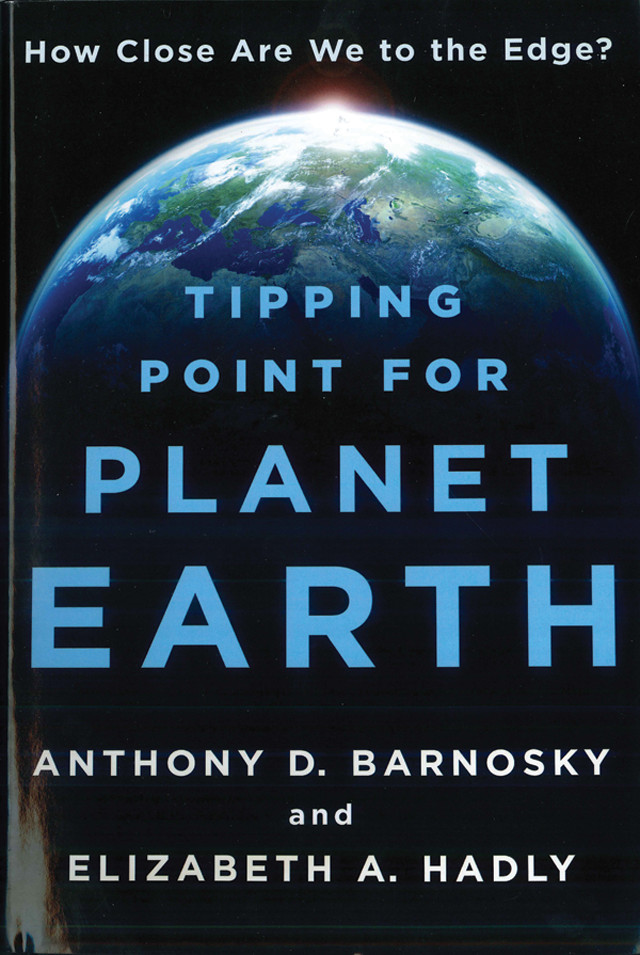
by William F. Ruddiman Friday, July 21, 2017

"Tipping Point for Planet Earth," Anthony D. Barnosky and Elizabeth A. Hadly, Thomas Dunne Books, 2016, Hardcover, ISBN-13: 978-1250051158.
The 2016 book, “Tipping Point for Planet Earth,” by paleoecologists Anthony D. Barnosky and Elizabeth A. Hadly, is a serious book on a serious topic, and a well-written, one-stop resource for anyone who wants to understand a host of looming problems. The book focuses on the alarming number of worrisome planetary trends now underway, mainly as a result of the convergence of population growth and human-induced global warming. Chapters cover people (population growth), “stuff” (increased purchases of material goods), storms, hunger, thirst (failing water supplies, clean or not), toxins, disease and war. These trends have merited serious attention from environmental scientists and deserve the same from politicians. Whether they are tipping points, however, is a point of contention.
Personally, I am not enamored of the phrase “tipping point.” Since the 2000 publication of Malcolm Gladwell’s book “The Tipping Point: How Little Things Can Make a Big Difference,” people have often used it as an attention-grabbing soundbite. For example, the rise of atmospheric carbon dioxide past 400 parts per million (ppm) in recent years is not a “tipping point,” despite being described that way. The carbon dioxide level has been increasing slowly for 150 years, so 400 ppm is no more a tipping point than 397 or 403 ppm. The phrase should be used with care.
Reading Barnosky and Hadly’s work, it was not entirely clear whether the authors themselves regard the recent environmental disasters they discuss — such as the Yellowstone fires in 1988 and Hurricane Sandy in 2012 — as actual tipping points. Newsworthy events like these are important (and in some cases unprecedented) departures from the range of variation of the climate system during previous decades. But in these and other cases, the system does not “tip” into an entirely different pattern; instead, its behavior reverts back to the previous range of natural variability, albeit with a slow increase in extreme events.
My objections about tipping points need a caveat. Earth certainly does have tipping points, and one already underway, with major effects to be felt later and slowly, is the irreversible future sea-level rise of many meters caused by the destabilization of several ice drainage basins in Antarctica that are lifting off underlying pinning points on their rocky beds.
Semantics about proper use of “tipping point” aside, my main criticism of Barnosky and Hadly’s writing is its relentlessly downbeat tone, which I found off-putting. At one point early in the book, for example, the authors write: “What is now normal … through most of the world, is a landscape and seascape that has been so changed by humanity that our life-support systems are teetering precariously on the brink of collapse.” How many readers, especially younger ones who matter so much to our future, will want to push through that kind of bleak claim and keep reading — much less try to effect change?
This downbeat approach has precedents in past predictions of environmental catastrophes that have not come to pass. In 1798, Thomas Malthus predicted massive famines as populations outran the ability of farmers to feed them. But Malthus was apparently unaware that farmers in crowded areas like China had for millennia been compensating for population growth by altering their farming methods to produce more food per acre, or that Dutch farmers were doing the same thing during the centuries prior to his predictions. Malthusian collapse has been repeatedly averted by human innovation, with famines restricted to areas hit by local drought.
Barnosky and Hadly tend to highlight bad news and gloomy forecasts while paying less attention to good news. Examples of good news include improvements in global access to clean water and decent sanitation, decreases in the incidence of infectious diseases like leprosy, polio, Guinea worm and river blindness, and new innovations, such as CRISPR gene-splicing technology, which promise major advances in fighting stubbornly resistant diseases like malaria. Additionally, wind energy costs have fallen by a factor of 10 in the last few decades, solar energy in the U.S. had its biggest year ever in 2016 (and is expected to triple over the next five years), and battery storage technology has experienced remarkable recent advances.
These transitions in energy resources seem to me like potential tipping points, but very positive ones. And if they continue for a few more decades, how might they affect the trajectories of some of the distressing global trends Barnosky and Hadly cover? I would read with great interest a book that tried to balance both the positive and negative trends to gain insight into what their complicated interactions portend for the future.
© 2008-2021. All rights reserved. Any copying, redistribution or retransmission of any of the contents of this service without the expressed written permission of the American Geosciences Institute is expressly prohibited. Click here for all copyright requests.